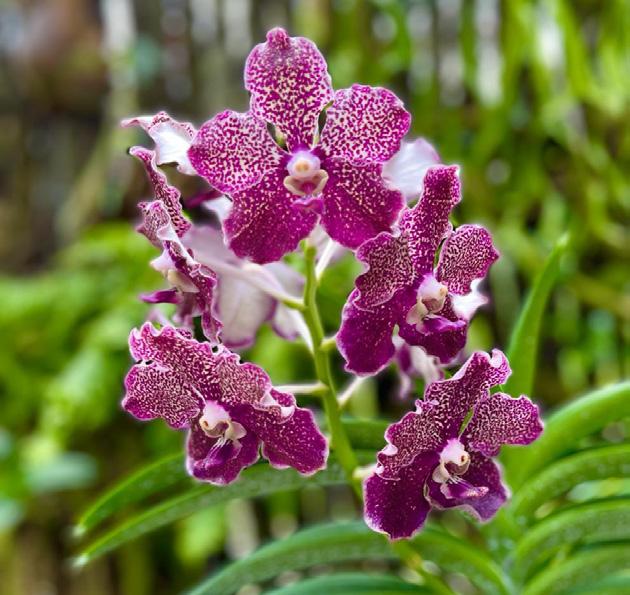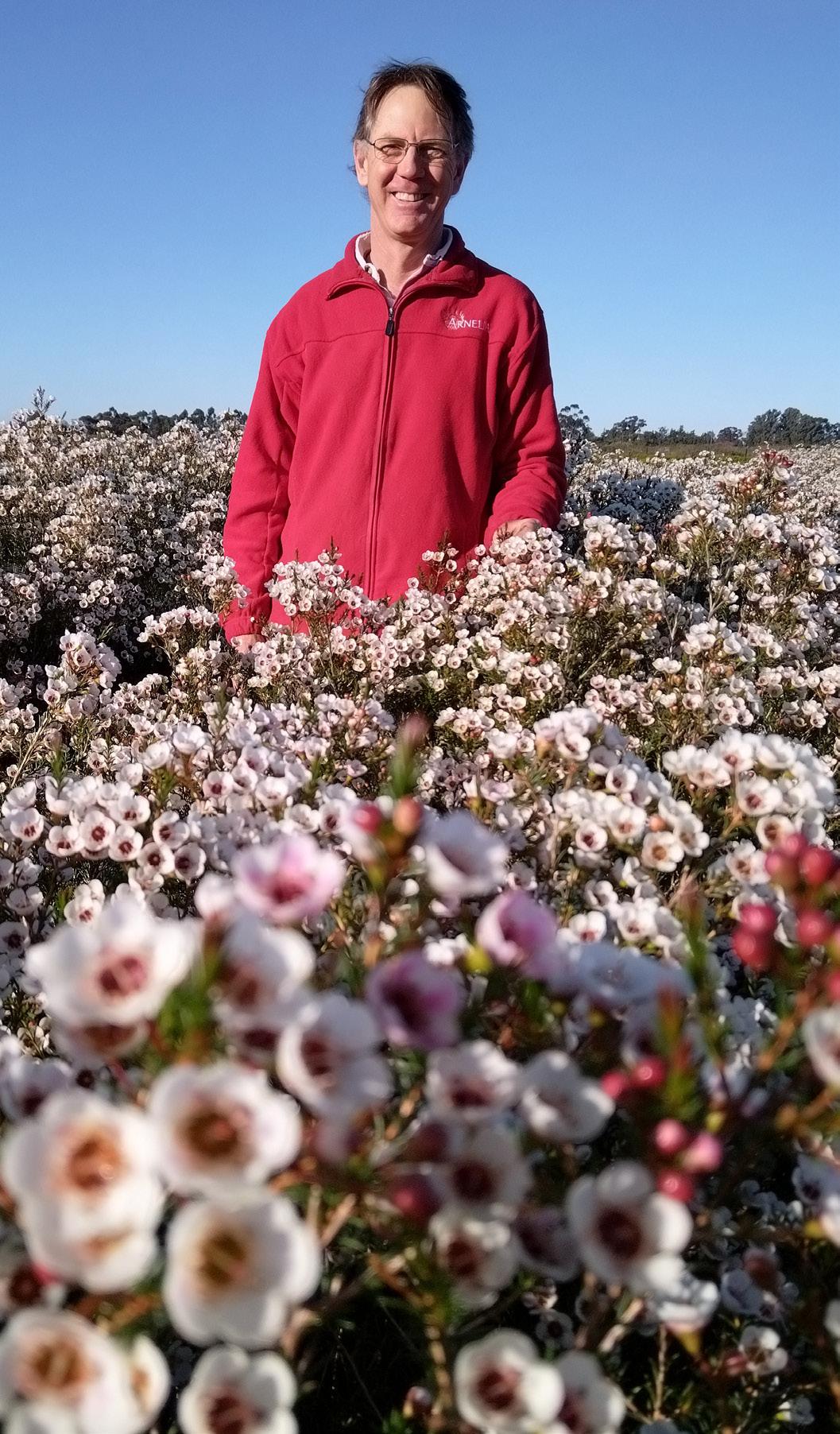
13 minute read
WANTABLE WAXFLOWERS BY ARNELIA
Wantable waxflowers by Arnelia: from add-on to primary cut flower crop
The goal of Hans Hettasch from South Africa-based cut flower nursery Arnelia Farms is always to try to grow the perfect waxflower. One which is strong and healthy, of a fashionable shape, and will perform superbly in any bouquet. He talks to FCI about the inaugural Waxflower Tour in South Africa, his blooming partnership with renowned wax flower breeders Helix Australia and Digby Growns, his biggest achievement in waxflower production and propagation, and the state of the trade.
Advertisement
AUTHOR: RON VAN DER PLOEG. PHOTO: ARNELIA FARMS Hans Hettasch founded Arnelia Farms in 2002. At that time, the company focused more on Proteaceae cut flower production (Leucospermum, Leucadendron and Protea), while waxflower was an add-on. Over the years, waxflower became increasingly important in production volumes and value, and today it is Arnelia’s primary cut flower crop. Today, the farm spans a production area of 60ha, of which approximately 40ha is used for the field production of waxflower. When Hettasch phones in from Hopefield, 100 km north of Cape Town, the inaugural Waxflower Tour South Africa lies only a few days behind him. Arnelia’s willingness to open its farm allowed growers Efraim Gafni from Gafni Farm, Omer Kessler from Said Ronen Farm, technical adviser Gershon Itzhak and marketeer Lihi Salpeter- Danziger from Blooms Floral Imports – all from Israel - to experience hands on the production and farms that shaped South Africa’s thriving waxflower industry. The educational trip was led by Adrian Parsons, chief executive of waxflower breeder Helix Australia, and Digby Growns from Kings Park and Botanic Gardens (KPBG), Perth, Western Australia, another famed expert in the field of waxflowers.
FCI: How did the event help South Africa’s wax flower industry progress?
Hans Hettasch: “Interaction between growers is always valuable, and exchanging ideas regarding production, propagation and technical issues was great. Gaining a better perspective on Northern hemisphere production and marketing puts many things in perspective for South African waxflower growers, as Israel is the world’s biggest waxflower producing country. Thanks to strong production in both Northern and Southern hemisphere, waxflower is available in most markets year-round.”
What do you think was the tour’s absolute highlight?
“The tour offered Arnelia the opportunity to showcase the Helix varieties in production, as cut flowers and potted plants. Participants saw several excitingly new breeding numbers under evaluation. Having the legendary waxflower breeder, Digby Growns, in the group to explain some of the breeding and evaluation processes and give everyone some insight into the pipeline of new varieties yet to come was amazing.”
You grow waxflower from URC, a task not for the faint-hearted, am I right?
“Having the right conditions in the propagation greenhouse, healthy mother stock, timing and choosing the right material to propagate from are all important factors in successful waxflower propagation. Some varieties are tough to propagate and require specific techniques. We continuously improve our strike rates and the quality of rooted cutting we produce.”
Over the years, you have become an experienced waxflower grower. Technically speaking, what does it take to succeed in a waxflower crop?
“Waxflower has a set of unique growing conditions which can make the plants quite tricky to grow if they are not met. Each variety has its nuances of challenges, and growing techniques must be adapted accordingly. Climate, soil conditions, nutrition, and crop protection are all technical matters that need constant attention to detail.”
Many years ago, you teamed up with Mike Cramer of the University of Cape Town in a trial exploring nutrition in Proteas (another flagship product of Arnelia). Tell us about nutrition for waxflowers.
“Finding the right balance of nutrients for optimal production of each variety we grow is an ongoing affair. All commercial varieties are growth-tracked, and regular soil and leaf sampling help guide our nutrient mixes and rate decisions. Knowing when each variety initiates flowers is important. Trying to limit overgrowth without compromising leaf quality on the plant is always a balancing act that requires close monitoring and agile management.”
What achievement are you most proud of?
“To work closely with Helix Australia on trialling and commercialising new waxflower varieties and bringing them to the global market. We continue to work hard to produce consistent,
high-quality cut flowers for all our clients. We started working together in 2008. Access to new waxflower varieties has been Arnelia’s key growth driver. As Helix Australia expands the range of new varieties being trialled and commercialised from the breeding programme at Kings Park Botanic Garden, the scope for growth in waxflower production grows. New varieties from this breeding programme are so unique in colour, flower size and timing that I believe the commercial potential for production is enormous. Almost all of Arnelia’s waxflower production is of Helix varieties. We currently have 18 Helix varieties in commercial production and add new ones to our range every year.” Hans Hettasch in his waxflower harvest
Speaking of unique waxflowers, tell us about Helix’s exciting range of megalopetalum waxflowers and the two-toned Sweet16 series.
“The Chamelaucium megalopetalum hybrids not only have larger flowers but also produce their flowers in an umbrella shape over the top of the stem, rather than more laterally along the stem as Chamelaucium uncinatum does. The variety ‘My Sweet Sixteen’ is one of a kind, with flowers starting white and then maturing from pink to red. At its prime, ‘My Sweet Sixteen’ is sold with all three colours of flowers on the stem.”
What are the most important benefits of working with Helix’s PBR-protected varieties?
“New varieties are essential to Arnelia, and we understand that breeding is expensive and that to support a sustainable breeding programme in the long-term, protection of plant breeder’s rights and management of the relationship between growers and the breeder must be nurtured. Helix Australia is serious about the future of waxflower and working with its licenced growers to protect and manage their varieties in a way that benefits all parties in the long run.”
What can you tell about yields and prices?
Do you see an increase or decrease in South Africa’s plantation areas?
“In our country, plantings are rapidly increasing to meet market demand and incorporate new varieties into the assortment.”
How would you characterise your buyer’s audience?
“At Arnelia, we sell all our flowers directly from the farm to importers, wholesalers, and bouquet makers in markets around the world. We do our utmost to bring our waxflower varieties to as many markets as possible as directly as possible. I am convinced that there are many untapped opportunities for waxflower, especially as more and more new varieties become available, and our assortment of colours expands over the whole season.”
Do you find yourself in a buyer or seller’s market?
“In my opinion, it is almost always a buyers’ market, but by working as closely as possible with the buyers of our flowers, providing information on varieties and by promoting our new varieties, all the while working hard to provide the best possible quality and service we hope to be in a position where our flowers are sought after.”
What’s your biggest tip for staying on trend and attracting waxflower buyers?
“By working as closely as possible with the buyers of our flowers, we hope to be able to pick up on trends quickly. Most important to Arnelia is to supply a consistent quality product.”
What do you think are the critical gaps in the market?
“Good clean white with flowers over the top of the stems, throughout the season, is the most important priority. Furthermore, pinks and purples with the same flowering characteristics are also important. High yield and good vase life are critical.”
What is the outlook for the 2022/2023 waxflower season?
“We are positive that after the tough time we had sold flowers in the scorching Northern hemisphere mid-summer period, the demand will rapidly increase, and we can look forward to a good season.”
Plantarium|Groen-Direkt
AUTHOR & PHOTOS: :RON VAN DER PLOEG. Boskoop’s Royal Horticultural Society judges crowned Phlox paniculata ‘Olympus’ as Best in Show at Plantarium|GroenDirekt’s New Varieties Showcase.
KVBC’s judging panel highlighted the victorious plant as follows: “Phlox ‘Olympus’ has striking variegated foliage and young red shoots. This Phlox is a welcome new addition to the range, especially with its purple flowers. It’s suitable for use in private gardens and public green spaces.” The plant is bred by 55-year old Peter Geerlings, owner of Geerlings-Meyer BV from Hillegom. It was introduced by royalty management agency/ perennial plant intermediary Compass Plants BV and wholesale plant nursery Rijnbeek. The plant was one of 35 outstanding new selections on display at the 2022 Plantarium|Groen-Direkt show, held between 24-25 August at Boskoop’s International Trade Centre. The number of Bronze and Silver Medals awarded was 11 and seven, respectively. Peter Geerlings was thrilled when Helma van der Louw, chairwoman of Boskoop’s Royal Horticultural Society (KVBC), presented the show’s top accolade to Phlox paniculata ‘Olympus’, a plant he discovered in 2012 as a variegated sport on a seedling whose mother was the non-patented Phlox paniculata ‘Pixie Miracle Grace’, with a Phlox paniculata seedling selection as unknown father/pollen. Geerlings says he has fallen in love with the award-winning Phlox, and it is easy to see why. The new leaf growth in vibrant shades of red and purple in early spring put on a great show. It continues to shine in late summer as just before flowers unfold themselves, the leaves once again magically change colour. This time, it offers a twist of variegated foliage with green centres and white margins. Geerlings says: “What’s more, the blooms of Olympus are large and equally two-toned. They appear in clusters of delicately fragrant purple flowers with a white centre.” Launching the new variety - just like Phlox paniculata ‘Cleopatra’, ‘Zenobia’ and ‘Palmyra’ (also bred by Geerlings-Meyer BV) named after ancient gods and mythical homes of the gods – hasn’t been a small undertaking. Geerlings notes, “As ‘Olympus’ is the result of a mutation, it took me six years of trialling to exclude any ‘reverting’ - that is, a return to its natural state. The plant is 100 per cent stable, and we propagate them using soft tip cuttings. We can reproduce true to type over successive generations.” ‘Olympus’ is not the first variegated Phlox. The cultivar ‘Nora Leigh’ has been around for quite a while and Phlox breeders such as Rene van Gaalen from Delft also attempted to launch Phloxes with bi-coloured or tri-coloured foliage. And in ground-covering Phlox procumbens exists a ‘Variegata’ variety. But nothing compares with Olympus, says Geerlings. “’Nora Leigh’, for example, features bigger blooms and much smaller foliage with much white. And it certainly doesn’t have that tremendous red shade in spring and early summer.” Phlox paniculate ‘Olympus’ offers no better or worse mildew resistance than most Phlox types. It blooms right into late summer and stands 60-70 cm tall, depending on soil type and climate. The KVBC Awards are the beating heart of the AIPH-approved Plantarium|Groen-Direkt show showcasing the best in new plant introductions from plant suppliers. The trade show is also the place to find the best marketing concept. Griffioen from Boskoop scooped up the Green Concept Award for its Wild & Inheems (Wild & Native) concept. The jury unanimously voted for Wild & Inheems, “finding everything right about this concept that perfectly meets current market needs”. The concept includes a selection of sustainably grown wild and native plants in pots Phlox paniculata ‘Olympus’, bred by Peter Geerlings from Hillegom, won the show’s top accolade: the KVBC Gold Medal.
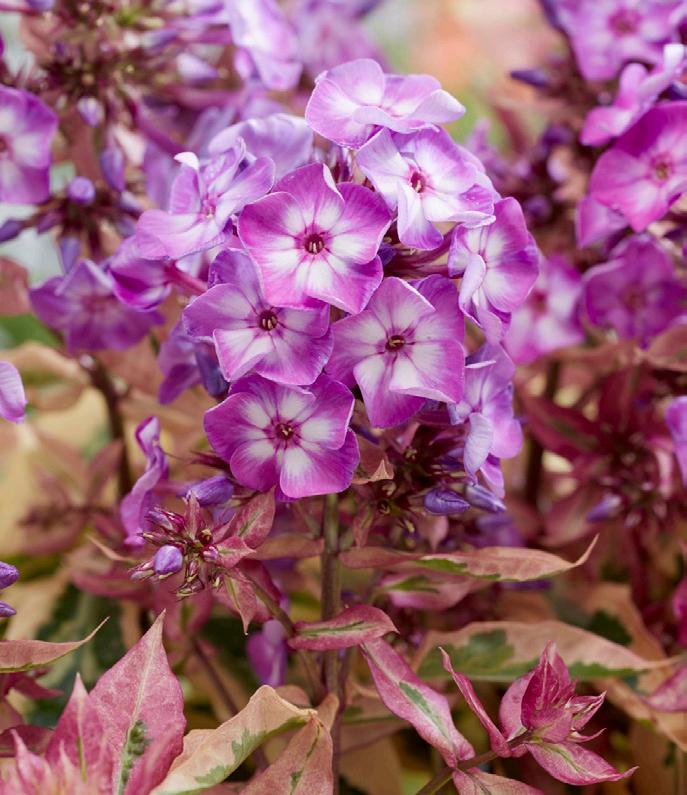
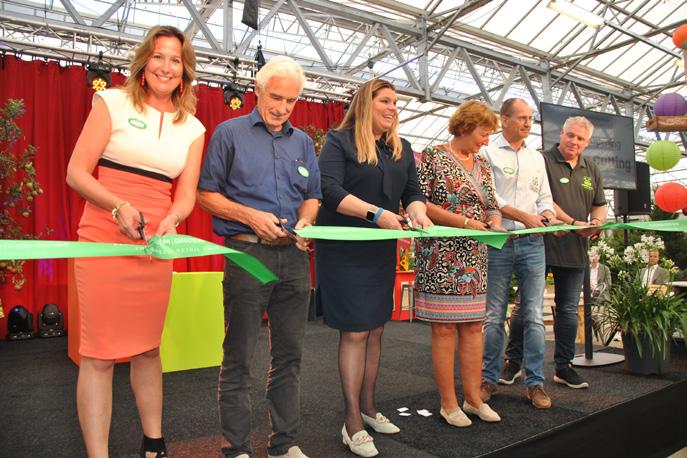
Cutting ribbon ceremony. Left to right Linda Hoogendoorn-Veelenturf (VARB), Michel Gerritsen (SVB), Anouk Noordermeer (Alderman Alphen aan den Rijn), Liesbeth Spies (Mayor Alpen aan den Rijn), Hans Cok (Groen-Direkt) and Taaf Rosbergen (Groen-Direkt).
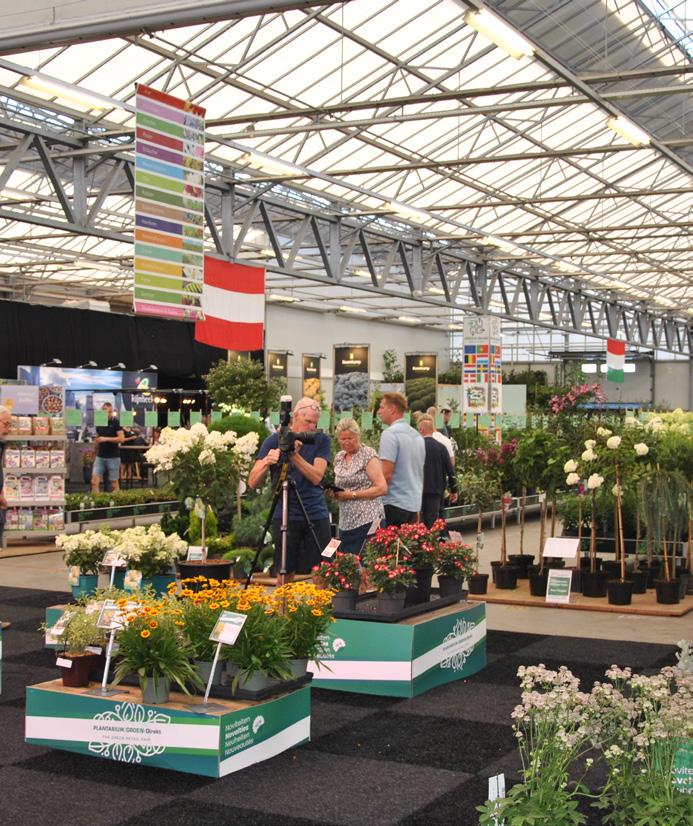
The KVBC Awards are the beating heart of the AIPH-approved Plantarium|Groen-Direkt show.
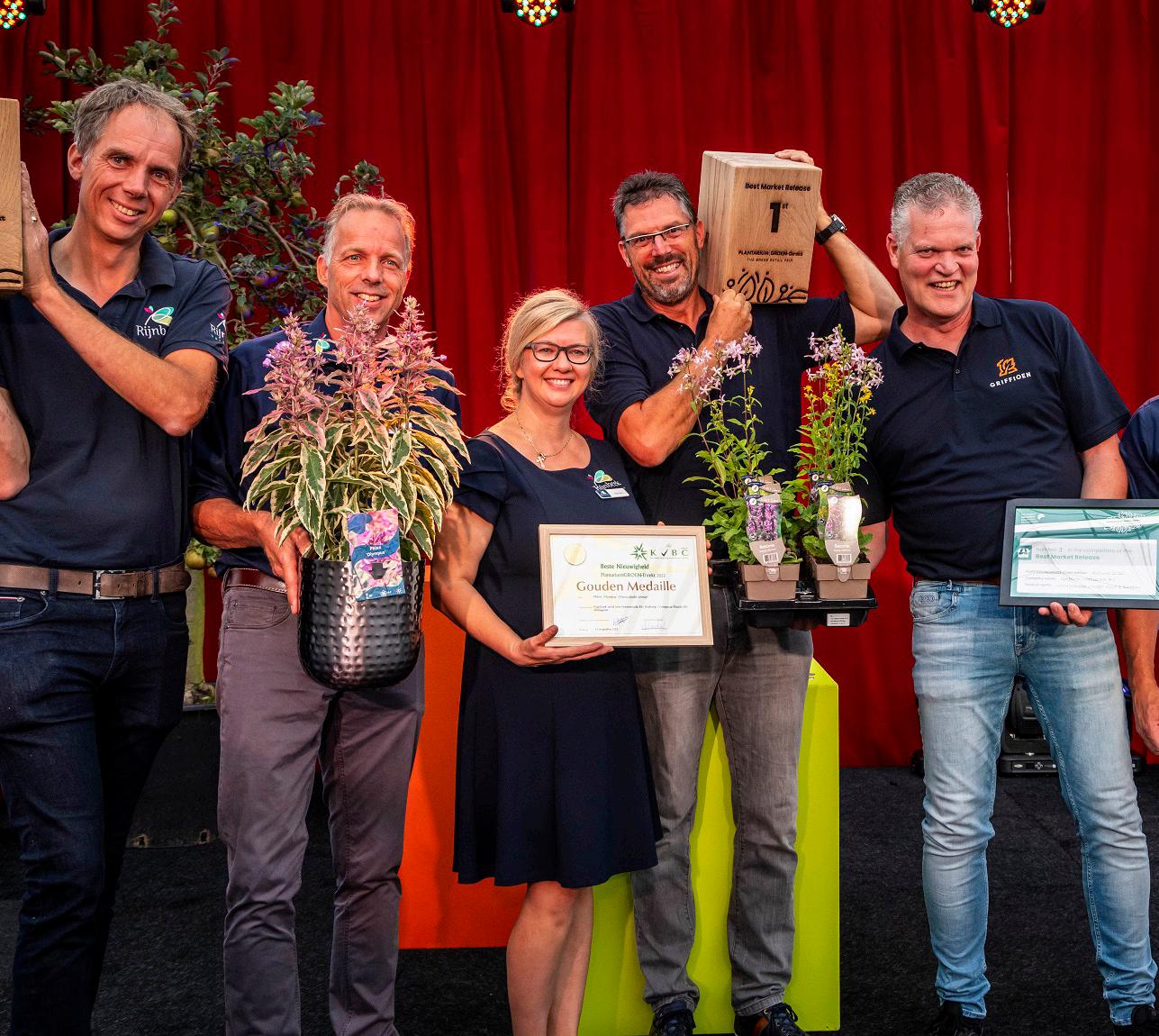
Group photo of the show’s award winners: Rijnbeek and Griffioen.
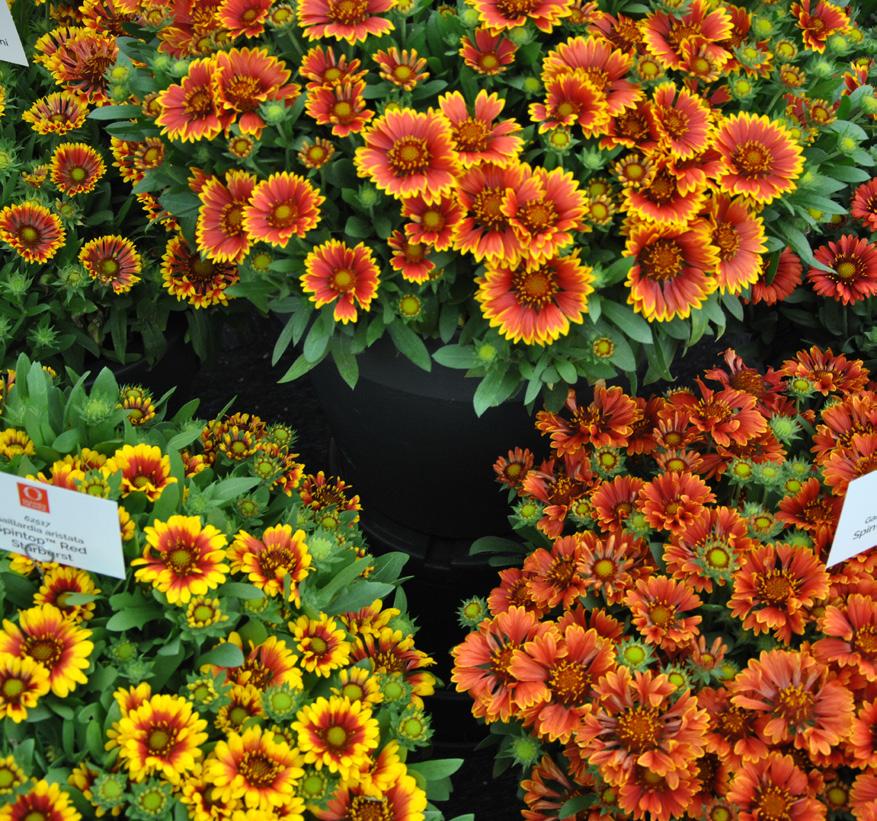
One of the showstoppers: Dümmen Orange’s Gaillardia aristata Spin Top series. from recycled plastic. According to the jury, the Wild & Native plants help promote biodiversity in each country so you can adapt the marketing concept accordingly by incorporating different plants to any region in Europe. The jury assessed 21 market concepts with Nature2Nature from plant nursery Van Son & Koot from Kaatsheuvel ending second. Nature2Nature includes a range of great pollinator plants in four categories: Birds, Bees, Butterflies and Bugs. The purpose-selected plants - all of which are hardy - come with a specific label depicting the plant and explaining which animals it attracts. The concept comes with a full range of (POP) Point of Purchase material. Nature4Nature is for any market segment: physical garden centres, DIY stores, and online plant delivery services. The concept is one of the answers to today’s eco-conscious shoppers. Van Son & Koot has an ambitious plan with Nature4Nature as it seeks “to inspire everyone and make the world greener”. The jury report reads: “The concept evolves around appealing storytelling, using a subdivision in four categories. The concept is fun for children and very topical, responding to the need for sustainability and biodiversity. And it impacts the way of gardening positively.” The show also presented People’s Choice awards, chosen by attendees voting on the scorching hot show floor. During the opening ceremony early Wednesday morning, 24 August, organisers bent over backwards to explain that the 2022 Plantarium|Groen-Direkt edition is a brand-new show, marking a new dawn for the international nursery stock industry. Perhaps a ‘rebrand’ rather than a ‘first’ as all industry professionals know that Plantarium and Groen-Direkt were events already held under one roof. The bottom line is that in February 2022, Jan de Vries, and Michiel Gerritsen of Stichting Vakbeurs voor de Boomkwekerij (SVB) and Taaf Rosbergen and Hans Cok of Groen-Direkt put their signatures to the agreement by which a new show organiser was formed: Green Retail Events tasked with Plantarium|Groen-Direkt as their first trade show. Once again, the term ‘new’ in show organiser’ is not absolute as the newly appointed organising committee includes six seasoned nursery stock experts. Plantarium and Groen-Direkt combined aim is to provide a spring and autumn trade show where growers locally and abroad can gather to showcase garden plants and share knowledge, best practices, new ideas and techniques so that horticulture never stands still. AIPH Secretary General Tim Briercliffe commented: “AIPH is pleased to have granted its approval to Plantarium |Groen-Direkt. The exhibition will provide a unique opportunity to see the new plants being introduced worldwide and to re-connect with producers and suppliers.” The total surface area of the fair was 22,500m2, and 214 international exhibitors from four continents participated. The green sector’s leading plant nurseries joined suppliers, alongside a selection of hardware suppliers for garden centres. Visitors found thousands of products in all shapes and sizes on display and plenty of opportunities to place orders directly at GroenDirekt’s Autumn Fair. This is arguably Europe’s largest wholesale plant/nursery stock sales event featuring 4,000 sample batches of plants on raised beds and a ‘Danish trolley fair’. The latter allows the company’s 1,000 active European buyers to buy plants in smaller quantities per Danish trolley layer. The plants on sale at Groen-Direkt are grown by 384 growers, of which 30 to 40 per cent is from the Boskoop area. www.plantariumgroendirekt.nl
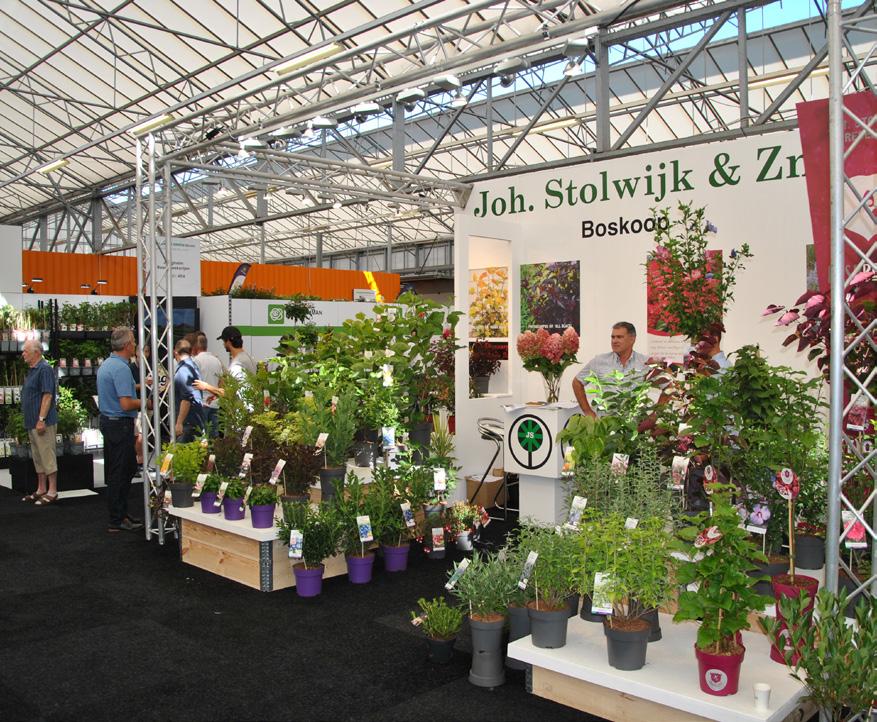
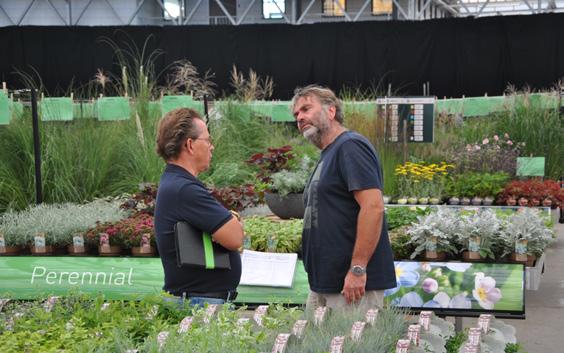
Plenty of opportunities to place orders directly at Groen-Direkt’s Autumn Fair.









